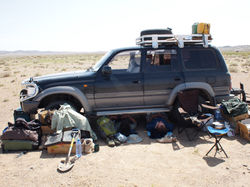
WildWall
Experiences
"Great Wall Outside China"
How can there be Great Wall outside China?
Great Wall Outside China: those ruins of ancient China’s border defence structures, or Great Walls, that no longer remain within the sovereign territory of the People’s Republic of China. The term refers to Great Walls within three states that share borders with China, i.e. Mongolia, Russia and North Korea. Term coined by British geographer and Great Walls researcher, William Lindesay OBE in 2011, after his first expedition to Mongolia to investigate a linear structure which appeared on Mongolian maps and was labelled ’The Wall of Genghis Khan'.
 |  |  |  |  |
|---|---|---|---|---|
 |  |  |  |  |

“To me, exploration is about going into the unknown, and thinking outside the box.”
William Lindesay
By its foreign name at least, it seems that Great Wall can only be in China. But what is ‘China’? It’s a place with a name that has been centred in the far east of the Asian landmass for millennia. While the location of it centre has remained pretty much unchanged, its edges have changed. This means that its size — its territorial spread — has varied over these millennium.
Today’s China, the People’s Republic, is approximately 9.8 million square kilometres. Qing China, of circa 1750, was 14.8 million kilometres. Qin China, of circa 220 BC, was about 5.5 million square kilometres.
Over the millennia the different dynasties ruling China, or parts thereof when it fragmented, sometimes did, and sometimes did not, build border defences — or Great Walls as we refer to them as nowadays. Most of the ruins of these structures lie with the present-day sovereign territory of the People’s Republic of China, while some no longer do, at least in part. Some are marooned in neighbouring lands…..

My curiosity over the prospect of Great Walls existing outside China was aroused by two experiences. First, on seeing a ‘comprehensive’ map of the different dynastic Great Walls, I wondered why some of them stopped abruptly at borders with northern neighbours, most of all with Mongolia, and in one case, North Korea. Second, having been given an Atlas of Mongolia I was excited to see that on some of its maps showed linear fortifications that were marked with a special symbol and labelled ‘The Genghis Khan Wall’.

In 2011 and 2012 I funded my own expeditions to two diffrent sections of the Genghis Khan Wall as shown on Mongolian maps.
My 2011 Genghis Khan Wall Expedition was concerned with the section of the structure in Omnogovi Aimag, in the South Gobi. In this, the widest, most hostile part of the gobi, we found and followed a fragmented section of the Wall for approximately 100 kms, discovering and documenting its form and condition to be quite varied. It varied in contruction from earth and saksaul branches to quarried basalt.
By what I refer to as ‘jigsaw’ theory, the Wall in Mongolia’s South Gobi matches up with Han Dynasty Great Wall (built circa late 2nd century BC) across the border in China quite perfectly, on both its western and eastern flanks. However, radiocarbon-14 dating of wooden materials found within the Wall’s fabric evidenced a surprising episode — an unknown, maybe ‘lost’ episode — of its history. With result dates ranging from 1040 to 1160 AD, it seems that this structure was at least rebuilt and reused during the 11-12th centuries AD by the Tangut people, whose heartland occupied the strategic Silk Road within the Hexi Corridor. I believe the Tanguts actually used this ‘Genghis Khan Wall’ in the defence of their land against Genghis Khan’s cavalry strikes on their land, which began in 1207.
 |  |  |  |  |
|---|---|---|---|---|
 |
My Second Genghis Khan Wall expedition was across the Eastern Steppe in Mongolia’s northeastern quadrant, in the summer of 2012. This is the longest section of Genghis Khan Wall in Mongolia. My team and I followed the structure, present as a low mound and shallow trench, across the steppe for a distance of 400 km, all the way to the barbed-wire fence marking the Mongolia-China border. From this point it continues east, under the fence, across the ploughed tract that acts as a fire-break, into China…..where it’s marked on maps as ‘Great Wall of China’.
I believe this section of the Genghis Khan Wall may actually have a connection to the great conqueror, apart from its name. In 'The Secret History of the Mongols', Genghis Khan’s third son and successor is recorded as having ordered the building of a wall, not as a defence, but to prevent wild beasts from migrating off the steppe…
 |  |  |  |  |
|---|---|---|---|---|
 |  |  |  |
My research into what I describe as both Genghis Khan Walls and Great Wall Outside China is continuing. Feature reports have been published in National Geographic Magazine (Chinese edition) and on the Nat Geo website.
I would like to thank Professor Bassan, Professor Halbertsma, Dr. Kirk Olson and Dondug for their help in organising my Genghis Khan Wall field research.
